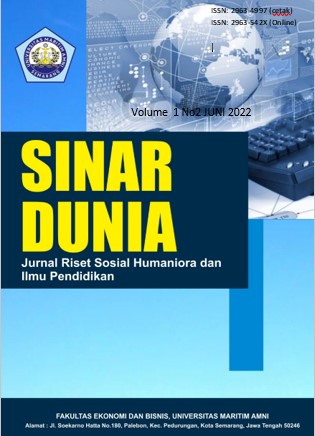Gambaran Ketidakpuasan Tubuh pada Remaja Putri Kelas VIII di SMP Negeri 2 Sragen
DOI:
https://doi.org/10.58192/sidu.v4i1.3114Keywords:
body, dissatisfaction, adolescentsAbstract
Individuals who assume that their physical condition is not the same as their ideal body concept, then the individual will feel physically lacking, this condition causes the individual to be unable to accept their condition as it is so that they can experience body dissatisfaction. The purpose of this study was to determine the picture of body dissatisfaction in adolescent girls. This study used qualitative method with 4 female adolescents in grade VIII at SMP Negeri 2 Sragen. The results of this study were 75% of students felt less confident and less satisfied with their body shape and 25% of students felt satisfied with their body shape because they had an athletic and good body, students also explained that they liked their healthy body which made them able to play volleyball well and win championships.
References
Andini, S. F. (2020). Aktivitas dan pengaruh sosial media terhadap body dissatisfaction pada dewasa awal. Jurnal Magister Psikologi UMA, 12(1), 34–43.
Bornioli, A., Lewis-Smith, H., Slater, A., & Bray, I. (2020). Body dissatisfaction predicts the onset of depression among adolescent females and males: A prospective study. Journal of Epidemiology and Community Health, 75(4).
Breakey, H. (2012). Intellectual liberty: Natural rights and intellectual property. Farnham Surrey: Ashgate.
Brooks-Gunn, J., et al. (dalam Rahmania & Ika). (2012). Hubungan antara self-esteem dengan kecenderungan body dysmorphic disorder pada remaja putri. Jurnal Psikologi Klinis & Kesehatan Mental, 1(2), 110–117.
Cahyani, A. E. (2020). Pengaruh coping stress terhadap body dissatisfaction pada wanita dewasa awal di Jakarta (Skripsi, Universitas Negeri Jakarta).
Cash, T. F., & Pruzinsky, T. (2002). Body image: A handbook of theory, research, and clinical practice. New York: Guilford Press.
Cooper, P. J., Taylor, M. J., Cooper, Z., & Fairburn, C. G. (1987). The development and validation of the body shape questionnaire. International Journal of Eating Disorders.
Cresswell, W. J. (2013). Research design: Pendekatan kualitatif, kuantitatif dan mixed. Yogyakarta: Pustaka Belajar.
Croll, J. (2005). Body image and adolescents. Chest In, 40(35), 50.
Damaiyanti, & Iskandar. (2012). Asuhan keperawatan jiwa. Bandung: Refika Aditama.
Dunn, & Goke (dalam Cash, T. F., & Pruzinsky, T. (2002). Body image: A handbook of theory, research, and clinical practice. New York: Guilford Press.
Grogan, S. (2017). Body image: Understanding body dissatisfaction in men, women, and children. New York: Routledge.
Hidayah, K. (2017). Hubungan konsep diri dengan kecemasan sosial pada siswa kelas 2 SMA N 1 Tumpang (Skripsi, Universitas Islam Negeri).
Hurlock, E. B. (2006). Psikologi perkembangan: Suatu pendekatan sepanjang rentang kehidupan. Jakarta: Erlangga.
Hurlock, E. B. (2009). Psikologi perkembangan: Suatu pendekatan sepanjang rentang kehidupan. Jakarta: Erlangga.
Kam, S., & Prihadi, K. D. (2021). Why students tend to compare themselves with each other? The role of mattering and unconditional self-acceptance. 10(2), 441–447.
Marshall, C., & Lengyel, C. (2012). Body dissatisfaction among middle-aged and older women. Canadian Journal of Dietetic Practice and Research, 73(2), 241–247.
Nahdiyah, I. (2015). Hubungan antara body image dengan kepuasan hidup pada remaja yang mengalami obesitas di komunitas KAGUMI (Ikatan Wanita Gemuk Indonesia) (Skripsi, Universitas Islam Negeri Maulana Malik Ibrahim Malang).
Ogden, J. (2010). The psychology of eating: From healthy to disordered behavior (2nd ed.). West Sussex: John Wiley & Sons.
Pakki, S. (2018). Issues related to body image in young adult women. Saudi Journal of Humanities and Social Sciences, 3(2), 250–254.
Rosen, J., & Reiter, J. C. (1995). Cognitive behavioral body image therapy for body dysmorphic disorder. Journal of Consulting and Clinical Psychology, 63(2), 263–269.
Santrock, J. W. (2005). Adolescence: Perkembangan remaja. Jakarta: Erlangga.
Santrock, J. W. (2007). Psikologi pendidikan (edisi kedua). Jakarta: Kencana Prenada Media Group.
Sobur, A. (2013). Semiotika komunikasi. Bandung: Remaja Rosdakarya.
Taddabur (dalam Pratiwi, L. R.). (2021). Pengaruh body image terhadap kepercayaan diri pada remaja modelling di Andika Production (Skripsi, Universitas Medan Area).
Tylka, T. L., & Sabik, N. J. (2010). Integrating social comparison theory and self-esteem within objectification theory to predict women’s disordered eating. A Journal of Research, 63(1–2), 18–31.
Yuanita, H., & Sukamto, M. E. (2013). Fenomena body dissatisfaction pada anggota fitness centre. Jurnal Psikologi dan Terapan, 4(1), 12–23.






